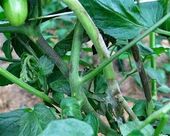Potato famine disease striking home gardens in U.S.

By Julie Steenhuysen - Fri Jul 10, 5:22 pm ET
Chicago (Reuters) - Late blight, which caused the Irish Potato Famine of the 1840s and 1850s, is killing potato and tomato plants in home gardens from Maine to Ohio and threatening commercial and organic farms, U.S. plant scientists said on Friday.
"Late blight has never occurred this early and this widespread in the United States," said Meg McGrath, a plant pathologist at Cornell University's extension center in Riverhead, New York.
She said the fungal disease, spread by spores carried in the air, has made its way into the garden centers of large retail chains in the Northeastern United States.
"Wal-mart, Home Depot, Sears, Kmart and Lowe's are some of the stores the plants have been seen in," McGrath said in a telephone interview.
The disease, known officially as Phytophthora infestans, causes large mold-ringed olive-green or brown spots on plant leaves, blackened stems, and can quickly wipe out weeks of tender care in a home garden.
McGrath said in her 21 years of research, she has only seen five outbreaks in the United States. The destructive disease can spread rapidly in cooler, moist weather, infecting an entire field within days.
"What's unique about it this year is we have never seen plants affected in garden centers being sold to home gardeners," she said.
This year's cool, wet weather created perfect conditions for the disease. "Hopefully, it will turn sunny," McGrath said. "If we get into our real summer hot dry weather, this disease is going to slow way down."
Fungicides Will Control Blight
According to its website, the University Maryland's Plant Diagnostic Lab got a suspect tomato sample as early as June 12, very early in the tomato growing season, which runs from April-September.
McGrath said the risk is that many gardeners will not recognize it, putting commercial farms and especially organic growers at risk.
"My concern is for growers. They are going to have to put a lot more time and effort in trying to control the disease. It's going to be a very tough year," she said.
"This pathogen can move great distances in the air. It often does little jumps, but it can make some big leaps."
McGrath said the impact on the farmer will depend on how much the pathogen is spread. "Eastern New York is seeing a lot of disease," she said.
She said commercial farmers will be able to use fungicides containing chlorothalonil to control the blight.
And while some sprays have also been approved for organic use, many organic farmers do not use them, making it much harder to control.
"If they are not on top of this right from the very beginning, it can go very fast," she said.



Reader Comments
to our Newsletter